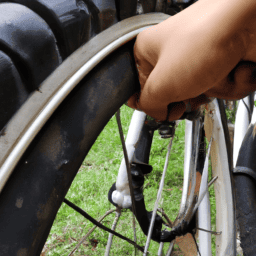It’s ironic to me how some folks view wearing a bike helmet as either uncool or not needed. Having been in a bike crash myself and having my helmet save me, I can’t emphasize enough how crucial it is to safeguard your head when you’re cycling.
But who is required to wear a bicycle helmet? The answer may surprise you.
In many places, there are legal regulations that require cyclists to wear helmets, especially for children. However, even if there aren’t any laws in your area, it’s still highly recommended to wear a helmet for safety reasons.
In this article, we’ll dive into the legal requirements for wearing a bicycle helmet, the benefits of doing so, and how to choose the right helmet for your needs.
So, whether you’re a seasoned cyclist or just getting started, read on to learn why wearing a helmet should be a top priority.
Key Takeaways
- Legal regulations require helmets in many places, making it mandatory for certain groups/ages to wear a bicycle helmet.
- While helmet exemptions may exist for certain groups/ages, wearing a helmet is highly recommended for safety reasons and reduces the risk of head injury and concussions.
- Cycling education and road infrastructure are also crucial for safety while cycling.
- Choosing the right helmet is essential, and it should meet safety standards, have a hard outer shell, thick foam liner, ventilation holes, and a proper fitting to increase visibility to other riders/drivers and enhance safety and enjoyment of cycling.
Overview of Cycling Safety
If you want to stay safe while cycling, you should always wear a helmet – it’s the most important piece of gear you can have.
But staying safe on a bicycle involves more than just wearing a helmet. Cycling education and road infrastructure are also important factors in ensuring your safety on the road.
Cycling education can teach you how to ride confidently and safely on the road, as well as how to communicate with other road users. Road infrastructure, such as bike lanes and traffic calming measures, can also make cycling safer and more accessible.
By combining safe cycling practices, education, and infrastructure, we can create a safer environment for all cyclists. With these factors in mind, it’s important to know the legal regulations surrounding cycling safety to ensure you’re following the law and staying safe on the road.
Legal Regulations
You might not be aware of the legal regulations surrounding head protection while cycling. In most countries, wearing a bicycle helmet is not mandatory for all cyclists. However, laws regarding helmet use may vary depending on the jurisdiction, age, and type of cycling activity. Here are some important points to keep in mind regarding helmet exemptions and enforcement measures:
-
Helmet exemptions: Some countries exempt certain groups of people from wearing a helmet while cycling, such as professional cyclists, messengers, or riders of certain types of bicycles. Additionally, some jurisdictions exempt certain age groups from mandatory helmet use, such as children under a certain age. It’s important to check the specific regulations in your area to know if you’re required to wear a helmet while cycling.
-
Enforcement measures: Even if helmet use isn’t mandatory, some regions may have enforcement measures in place to promote helmet use and safety. For example, some cities offer incentives or discounts for wearing a helmet, while others have public awareness campaigns to encourage helmet use. Some jurisdictions may also enforce helmet use for certain cycling activities, such as mountain biking or racing.
It’s essential to understand the legal regulations in your area regarding helmet use while cycling. While helmet use may not be mandatory for all, it’s still highly recommended for safety reasons. In the next section, we’ll discuss the benefits of wearing a helmet while cycling.
Benefits of Wearing a Helmet
As someone who’s been an avid cyclist for years, I can’t stress enough the importance of wearing a helmet while biking.
Not only does it provide essential protection from head injuries, but it also increases visibility to other riders and drivers on the road.
Additionally, the psychological benefits of wearing a helmet can also boost your confidence and make you feel safer while cycling.
Remember, safety should always be a top priority when it comes to biking, and wearing a helmet is a crucial part of that.
Protection from Head Injuries
Helmet use is essential for safeguarding against head injuries while cycling. As a cyclist, I understand the importance of wearing a helmet each time I ride. Without it, I’m at risk of sustaining serious head injuries that could have lasting consequences.
Research shows that helmets significantly reduce the risk of head injury and can even prevent concussions. The design of helmets has improved greatly over the years, with advanced materials and technology being incorporated into their construction. Helmets are now lighter, more comfortable, and better shaped to provide maximum protection. It’s important to choose a helmet that fits properly and meets safety standards to ensure optimal protection.
By wearing a helmet, I feel more confident and secure while cycling, knowing that I’m doing everything I can to protect myself from potential head injuries.
Increased visibility is another important aspect of cycling safety.
Increased Visibility
To truly stand out on the road, I highly recommend adding reflective gear to your cycling outfit. Whether it’s reflective tape on your clothing or bike, this simple addition can make all the difference in terms of safety.
As cyclists, we’re often hard to see, especially at night. Reflective gear can make us visible from miles away, giving drivers plenty of time to react and avoid a collision. In addition to reflective gear, bike lights are also a great investment. These lights not only make us visible to drivers, but also help us see the road ahead, especially during night rides.
Investing in reflective gear and bike lights can truly be a game-changer in terms of safety. It’s impossible to overstate the importance of being seen by drivers, especially in low light conditions. Not only does this increase our physical safety, but it also provides a sense of psychological comfort knowing that we’re doing everything in our power to avoid accidents.
With that said, the benefits of reflective gear and bike lights go beyond just safety. Let’s explore the psychological benefits in the next section.
Psychological Benefits
You’ll be pleasantly surprised to find that investing in reflective gear and bike lights not only enhances your safety, but also boosts your confidence and overall enjoyment of cycling. The psychological benefits of increased visibility on the road are often overlooked, but they play a crucial role in promoting mental health and self efficacy. When you feel safe and visible, you are more likely to have positive experiences while cycling and feel more confident in your abilities.
To illustrate the importance of visibility and the resulting psychological benefits, consider the following table:
| Without Reflective Gear and Bike Lights | With Reflective Gear and Bike Lights |
|---|---|
| Anxiety and fear of being hit by a car | Confidence and peace of mind while riding |
| Tension and stress from being unable to see the road ahead | Relaxation and enjoyment of the cycling experience |
| Lack of control and feeling vulnerable | Sense of control and empowerment over one’s safety |
As you can see, investing in reflective gear and bike lights not only enhances your safety, but also has a positive impact on your mental health and self efficacy. With these benefits in mind, it’s important to also choose the right helmet to further ensure your safety on the road.
Choosing the Right Helmet
When biking, make sure your noggin is protected by donning the appropriate headgear. Choosing the right helmet is crucial for your safety, and there are several factors to consider before making a purchase. Here are some helmet features and fitting tips you should keep in mind:
- Look for a helmet that meets safety standards set by organizations like the Consumer Product Safety Commission (CPSC) or the American National Standards Institute (ANSI).
- Choose a helmet with a hard outer shell and a thick foam liner to absorb impact.
- Look for a helmet with ventilation holes to keep your head cool and comfortable.
Fitting tips:
- Make sure the helmet fits snugly on your head, but not too tight.
- Adjust the helmet straps so they form a V-shape under your ears and are snug but not too tight.
- The helmet should sit level on your head and cover your forehead without obstructing your vision.
By following these tips, you can ensure that you’re choosing the right helmet that fits you well and provides optimal protection. Remember, wearing a helmet isn’t only a good idea, but it’s also the law in many states. So, don’t take any risks and always wear a helmet when you ride your bike.
Frequently Asked Questions
Can wearing a helmet prevent all head injuries while cycling?
Wearing a bicycle helmet can significantly reduce the risk of head injury while cycling. However, it is important to note that helmets are not 100% effective in preventing all head injuries. It is always important to prioritize safety while cycling.
Are there any health risks associated with wearing a bicycle helmet?
Wearing a bike helmet is essential for headache prevention and protecting the head from serious injury. However, prolonged use may cause hair damage. It is important to choose a well-fitted helmet to ensure maximum safety and comfort.
How often should a bicycle helmet be replaced?
To ensure optimal protection, I replace my bicycle helmet every 3-5 years, or sooner if it’s been involved in a crash. Proper care and storage can extend its lifespan, but don’t compromise safety for savings.
Are there any age restrictions on helmet-wearing for cyclists?
As a cyclist, it is important to know that there are legal requirements for helmet-wearing while riding. Age restrictions may vary by location, but it is always safest to wear a helmet regardless of age. Regularly check for proper fit and replace any damaged helmets.
What should I do if my helmet doesn’t fit properly?
If my helmet doesn’t fit properly, I can adjust the straps and padding for a snug fit. If it still doesn’t fit, I can consider trying on different sizes or helmet alternatives to ensure my safety while cycling.
Conclusion
In conclusion, wearing a bicycle helmet isn’t just a legal requirement in some places, it’s also a crucial safety measure for cyclists of all ages and skill levels. The benefits of wearing a helmet far outweigh any inconvenience or discomfort it may cause.
A real-life example of this is the case of a cyclist who was struck by a car and suffered a traumatic brain injury. Despite the severity of the accident, the cyclist’s helmet saved their life and minimized the extent of their injuries.
When it comes to choosing a helmet, it’s important to prioritize safety over style or fashion. Look for helmets that meet safety standards and fit properly to ensure maximum protection.
Remember, the helmet you wear could be the difference between life and death in the event of an accident. So always wear a helmet when cycling, and encourage others to do the same.
Let’s make cycling a safe and enjoyable activity for everyone.
















